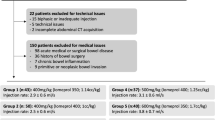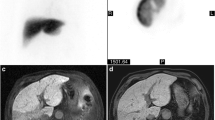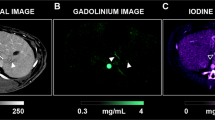Abstract
THE rapid development and general acceptance of contrast media represents one of the outstanding successes of diagnostic röntgenology. Roentgen contrast media are generally di- or tri-iodo derivatives of benzene or pyridine, containing further substituents influencing solubility. The most widely used contrast compounds are 3,5-diiodo-4-pyridon-N-acetic acid as its diethanolamine salt (‘Iodopyracet’, ‘Diodrast’, ‘Diodone’, ‘Ioduron’, etc.), and N-methyl-3,5-diiodo-chelidamate as its disodium salt (‘Neo-Iopax’, ‘Iodoxyl’, ‘Uropac’, etc.). A new compound of the urotropic class is sodium-3-acetyl-amino-2,4,6-tri-iodobenzoate known as ‘Triopac’, ‘Urokon’, ‘Triumbren’ and diacetylamino-2,4,6-triiodobenzoic acid, the methylglucamate of which is known as ‘Urografin’. The hepatotropic contrast media are represented by N,N′-adipyl-bis(3-amino-2,4,6-triiodo)-benzoic acid as methylglucamate (‘Biligrafin’ or ‘Cholografin’) and 2-ethyl-3-(3′-amino-2,4,6-triiodophenyl)-propionic acid (‘Cistobil’, ‘Telepaque’).
This is a preview of subscription content, access via your institution
Access options
Subscribe to this journal
Receive 51 print issues and online access
$199.00 per year
only $3.90 per issue
Buy this article
- Purchase on Springer Link
- Instant access to full article PDF
Prices may be subject to local taxes which are calculated during checkout
Similar content being viewed by others
Author information
Authors and Affiliations
Rights and permissions
About this article
Cite this article
LIEBSTER, J., KÁCL, J. & BABICKÝ, A. Labelling of Radiographic Contrast Media with Iodine-131. Nature 183, 1474–1475 (1959). https://doi.org/10.1038/1831474a0
Issue Date:
DOI: https://doi.org/10.1038/1831474a0
This article is cited by
Comments
By submitting a comment you agree to abide by our Terms and Community Guidelines. If you find something abusive or that does not comply with our terms or guidelines please flag it as inappropriate.



